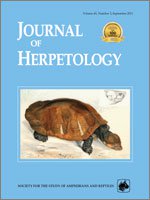Janthinobacterium lividum, a bacterium that inhibits the growth of the lethal amphibian pathogen Batrachochytrium dendrobatidis, has been found in myriad environments, including the skins of amphibians that resist the fungus. We present evidence that the gastrointestinal tract of Plethodon cinereus, the Eastern Red-backed Salamander, can serve as a reservoir for J. lividum. Two of six individuals collected from a natural environment harbored J. lividum in the gut tube. Violacein, whose intense violet color allows for rapid visual detection and chemical analysis, served as a first indicator for the presence of J. lividum. This secondary metabolite of J. lividum was confirmed through reverse-phase high performance liquid chromatography, UV-Vis analysis, and high-resolution mass spectrometry. The identity of J. lividum was confirmed by PCR amplification with J. lividum–specific primers of DNA extracted from the isolated bacteria. Because J. lividum survives in the digestive tract, it will likely be inoculated onto skin around the cloaca and into the soil and indirectly onto salamander skins. Thus, the gut may act as an important reservoir for this antifungal bacterium.
How to translate text using browser tools
1 September 2011
Gut of Red-backed Salamanders (Plethodon cinereus) May Serve as a Reservoir for an Antifungal Cutaneous Bacterium
Patrick J. Wiggins,
Jacob M. Smith,
Reid N. Harris,
Kevin P. C. Minbiole
ACCESS THE FULL ARTICLE

Journal of Herpetology
Vol. 45 • No. 3
September 2011
Vol. 45 • No. 3
September 2011




